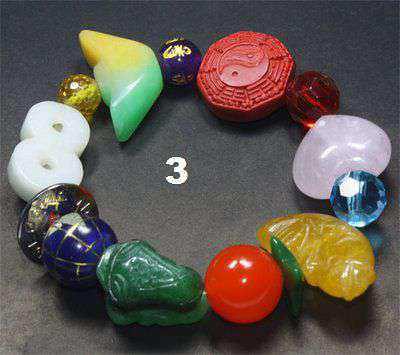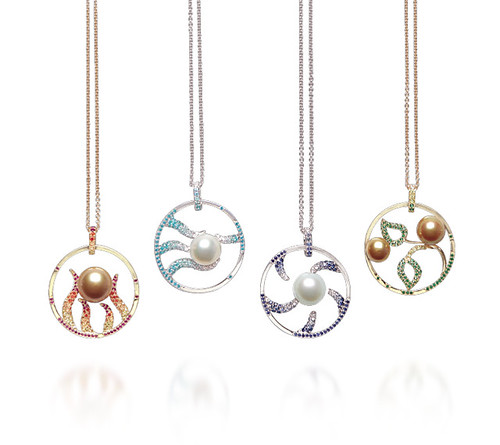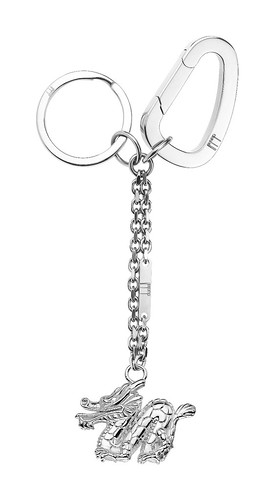It is believed that luck follows those born in the Year of the Dragon, which leads us to hope that this 2012 (Year of the Water Dragon) will bring more good news than bad news for the whole world.
And with good fortune on our side this 2012, together with hard work, let’s bring in the good vibrations this new lunar year with these suggested lucky charms:
Joy Lim introduced Filipinos to the wonderful world of auspicious charms, with celebrities and famous personalities as her main fans. One of her must-have accessories is the “Blessed All in One 8 Bracelet.” This is a mix of crystals that brings positive vibes in all aspects of life with the number 8 bead that represents the eight magical realms in Heaven and protects us from eight types of harm. The Aventurine Frog, meanwhile. is a money catcher that brings luck as well, with the Bagua balancing life. Other beads like the Fish stand for abundance, the Tael charm signifies wealth, the orange bead helps process transactions with ease, and the Rose Quartz improves love and relationships. For appointments and inquiries, call 742-2597 or 413-9112.
If sparkling jewelry is your preference, then you will definitely like Jewelmer’s latest collection of La Vita amulets. Take your pick from four pendants that symbolize the four powerful elements of life: blazing fire, cascading water, blowing air, and solid earth. Each medallion comes in a combination of South Sea pearls and colored stones that represents the four elements of life.
Men can also join in the good fortune with Dunhill’s set of polished sterling silver dragons. Each of these intricately carved dragons is attached to either a mobile phone strap or a keychain (with karabiner or ring clasp). Sterling silver cufflinks and pure silk ties in bold red, pale blue or pink with dragon motif are also available.
Showing posts with label Chinese New Year. Show all posts
Showing posts with label Chinese New Year. Show all posts
Thursday, February 23, 2012
Enter the Lucky Water Dragon
Labels:
Chinese New Year
Tuesday, December 7, 2010
Neutrogena's First Task for a Lighter YOU :D
Got a fabulous pic with the happiest smile you've got? Then join Neutrogena Fine Fairness' quest on starting the year light. Simply go to the Neutrogena Fine Fairness facebook page and post a picture of you with your most positive optimistic smile—because only good things are coming your way this new year!
* Photo taken from wikimedia
* Photo taken from wikimedia
Labels:
Chinese New Year,
Fine Fairness,
Neutrogena,
smile
Wednesday, March 3, 2010
Year of the Tiger Forecast
I know it's a bit late, but I would just like to share with you what I did for Manila Bulletin for Chinese New Year. The photos below were released last February 14.
Luck Is On Our Side
Arm yourself with Joy Lim’s charms and crystals
Arm yourself with Joy Lim’s charms and crystals
RAT
Lucky color: fuchsia, pink
Power bead/s: rose quartz in all shapes, to attract more love into your life.

OX
Lucky color: purple
Power bead/s: people who fall under the rooster sign will keep you safe from harm.

TIGER
Lucky color: purple
Power bead/s: Friends who are born under the rabbit sign, among others, will bring in good tidings.

SNAKE
Lucky color: blue
Power bead/s: Bring with you the three mythical beings that signify long life, fortune, and luck.

MONKEY
Lucky color: yellow
Power bead/s: Legendary creatures such as the pi-yao and the pi-xu protect you from bad luck.

ROOSTER
Lucky color: yellow
Power bead/s: A star to help you achieve your dreams, and the red bead to guide you on how to deal with the obstacles and trials that you'll encounter.

DOG
Lucky color: red
Power bead/s: The sequential numbers 1-6-8 means "one road to success." This will keep you focused on reaching your goals.

PIG
Lucky color: red
Power bead/s: Legendary symbols such as the holy gourd, pi-xu and the Tibetan beads all help to keep you away from misfortune.

Regarding the photos, I didn't want to be too literal with the animal forecast. So I translated the lucky colors into makeup, with the animals signs interpreted by the hairstylists. What do you think? :)
To know more about what the Year of the Tiger will bring for you, click on this link. For consultations, visit Charms & Crystals (main branch) at 22-B Dapitan Street, (near Mayon St.), Sta. Mesa Heights, Quezon City. Best to call 742-2597 for appointments. For a complete listing of branches, visit Charms and Crystals' website.
Photography by DIX
Makeup by Mikee Raymundo and Ricardo Carlos of M.A.C.Hairstyle by Helen Egan and Christopher Rodil of L’Oreal Professionnel
Models: Anna Claudia Amado and Ana Claudia Rotile or Mercator Models
Labels:
Chinese New Year
Friday, February 19, 2010
How to Greet Happy Chinese New Year in the Philippines
I know it's a bit late, but I just had to share this article. Did you ever wonder why there are different "Chinese New Year" greetings? For those who are curious, below is the explanation :)
Oh, and to celebrate the year of the Tiger... I'm giving away ENJOY kits to four (4) lucky readers. Contest rules will be posted on Monday, so visit us again next week :D Happy weekend everyone!
By Willard Cheng, ABS-CBN News | 02/13/2010 8:07 AM
A Chinese-Filipino finally puts the dilemma to rest
MANILA, Philippines - This Chinese New Year, you no doubt wonder which greeting is correct: Kung Hei Fat Choi or Kiong Hee Huat Tsia?
Both greetings refer to the same set of 4 Chinese characters that literally means “Congratulations and wishing you prosperity!”
Which one is the more approriate term when you are in the Philippines? (Actually, one term doesn't even mean "Happy New Year.")
“Kung Hei Fat Choi” has obviously been the more popular one, commonly said and printed on banners, advertisements and different forms of media. But this greeting is Cantonese.
Considering that majority of the Chinese Filipinos here in the Philippines speak the Hokkien dialect, I recommend that we say the greeting in Hokkien, which is pronounced and spelled as "Kiong Hee Huat Tsai."
MANILA, Philippines - This Chinese New Year, you no doubt wonder which greeting is correct: Kung Hei Fat Choi or Kiong Hee Huat Tsia?
Both greetings refer to the same set of 4 Chinese characters that literally means “Congratulations and wishing you prosperity!”
Which one is the more approriate term when you are in the Philippines? (Actually, one term doesn't even mean "Happy New Year.")
“Kung Hei Fat Choi” has obviously been the more popular one, commonly said and printed on banners, advertisements and different forms of media. But this greeting is Cantonese.
Considering that majority of the Chinese Filipinos here in the Philippines speak the Hokkien dialect, I recommend that we say the greeting in Hokkien, which is pronounced and spelled as "Kiong Hee Huat Tsai."
Lost in translation
Tsinoys will appreciate to hear the greeting in the dialect they understand.
Cantonese is one of the 9 other groups of dialects in China and is most commonly spoken in Hong Kong, Guangdong, and Macau.
Hokkien is the dialect spoken in Fujian province where most of the Chinese-Filipinos come from.
If you happen to be in China and if you want to say the greeting in Mandarin, China's official language (and spoken by the most number of people in the world), pronounce the greeting as "Kong Xi Fa Tsai" (written and spelled formally as "Gong Xi Fa Cai").
I suspect that a Hong Kong or Cantonese restaurant started to popularize the Cantonese greeting here, which is weird because there is a very scant population of Tsinoys from Guangdong or Hong Kong.
Quite disappointingly, the Cantonese greeting has been mercilessly repeated and spread in print ads and gigantic banners in commercial banks, restaurants, department stores and shopping malls supposedly owned by Hokkien-speaking Tsinoys who should know the difference.
I remember a jingle from a TV commercial of a fast food chain years ago that goes: “Kung Hei Fat Choi ay nandito na….” This is ironic, because the fast food chain is owned by a Chinese-Filipino who hails from Fujian.
Well, Tsinoys do not understand and speak “Kung Hei Fat Choi.” It’s like saying “Maayong buntag” (Good morning) to a Tagalog who doesn’t understand and speak Bisaya.
Spread the word
So, let's start banishing "Kung Hei Fat Choi" from our vocabulary and start to pratice saying the greeting in Hokkien, "Kiong Hee Huat Tsai," which is widely understood by Tsinoys here.
Spread the word, “Kiong Hee Huat Tsai!”
If you want to greet your friend “Happy New Year” in Mandarin, say it as “Xin Nien Kwai Le” (formally written as “Xin Nian Kuai Le”). In Hokkien, say it as “Sin Ni khòai lok.”
Also, don't also be confused with the lion and dragon dance, which are sometimes interchanged.
The four-legged dancing creature is a lion, which is maneuvered by two dancers (one moves the head while the other moves the tail).
It has wiggling ears and blinking eyes and is the one that also goes around the streets and reaches for the angpao or red envelope hung at the door. It is usually led by a masked man with a fan.
On the other hand, a dragon has a longer body that is maneuvered by more dancers. It is a guided by a man that holds a dragon ball.
Point out the difference when people say "There’s the dragon!" while the dancing creature turns out to be a lion.
Those are just some cultural nuances to take note of. To Filipinos and Filipino-Chinese alike, "Kiong Hee Huat Tsai!"
Tsinoys will appreciate to hear the greeting in the dialect they understand.
Cantonese is one of the 9 other groups of dialects in China and is most commonly spoken in Hong Kong, Guangdong, and Macau.
Hokkien is the dialect spoken in Fujian province where most of the Chinese-Filipinos come from.
If you happen to be in China and if you want to say the greeting in Mandarin, China's official language (and spoken by the most number of people in the world), pronounce the greeting as "Kong Xi Fa Tsai" (written and spelled formally as "Gong Xi Fa Cai").
I suspect that a Hong Kong or Cantonese restaurant started to popularize the Cantonese greeting here, which is weird because there is a very scant population of Tsinoys from Guangdong or Hong Kong.
Quite disappointingly, the Cantonese greeting has been mercilessly repeated and spread in print ads and gigantic banners in commercial banks, restaurants, department stores and shopping malls supposedly owned by Hokkien-speaking Tsinoys who should know the difference.
I remember a jingle from a TV commercial of a fast food chain years ago that goes: “Kung Hei Fat Choi ay nandito na….” This is ironic, because the fast food chain is owned by a Chinese-Filipino who hails from Fujian.
Well, Tsinoys do not understand and speak “Kung Hei Fat Choi.” It’s like saying “Maayong buntag” (Good morning) to a Tagalog who doesn’t understand and speak Bisaya.
Spread the word
So, let's start banishing "Kung Hei Fat Choi" from our vocabulary and start to pratice saying the greeting in Hokkien, "Kiong Hee Huat Tsai," which is widely understood by Tsinoys here.
Spread the word, “Kiong Hee Huat Tsai!”
If you want to greet your friend “Happy New Year” in Mandarin, say it as “Xin Nien Kwai Le” (formally written as “Xin Nian Kuai Le”). In Hokkien, say it as “Sin Ni khòai lok.”
Also, don't also be confused with the lion and dragon dance, which are sometimes interchanged.
The four-legged dancing creature is a lion, which is maneuvered by two dancers (one moves the head while the other moves the tail).
It has wiggling ears and blinking eyes and is the one that also goes around the streets and reaches for the angpao or red envelope hung at the door. It is usually led by a masked man with a fan.
On the other hand, a dragon has a longer body that is maneuvered by more dancers. It is a guided by a man that holds a dragon ball.
Point out the difference when people say "There’s the dragon!" while the dancing creature turns out to be a lion.
Those are just some cultural nuances to take note of. To Filipinos and Filipino-Chinese alike, "Kiong Hee Huat Tsai!"
Labels:
Chinese New Year,
Enjoy
Monday, February 15, 2010
Gong Xi Fa Cai
Had a very busy weekend. How was yours?
Went to Dangwa to buy flowers for V-day:

Had dinner with my in-laws, and at the stroke of midnight of the new year,
my side of the family lined up to ask for blessings—in different temples in Chinatown...

lighted candles for the "gods"
Labels:
Chinese New Year
Subscribe to:
Posts (Atom)











